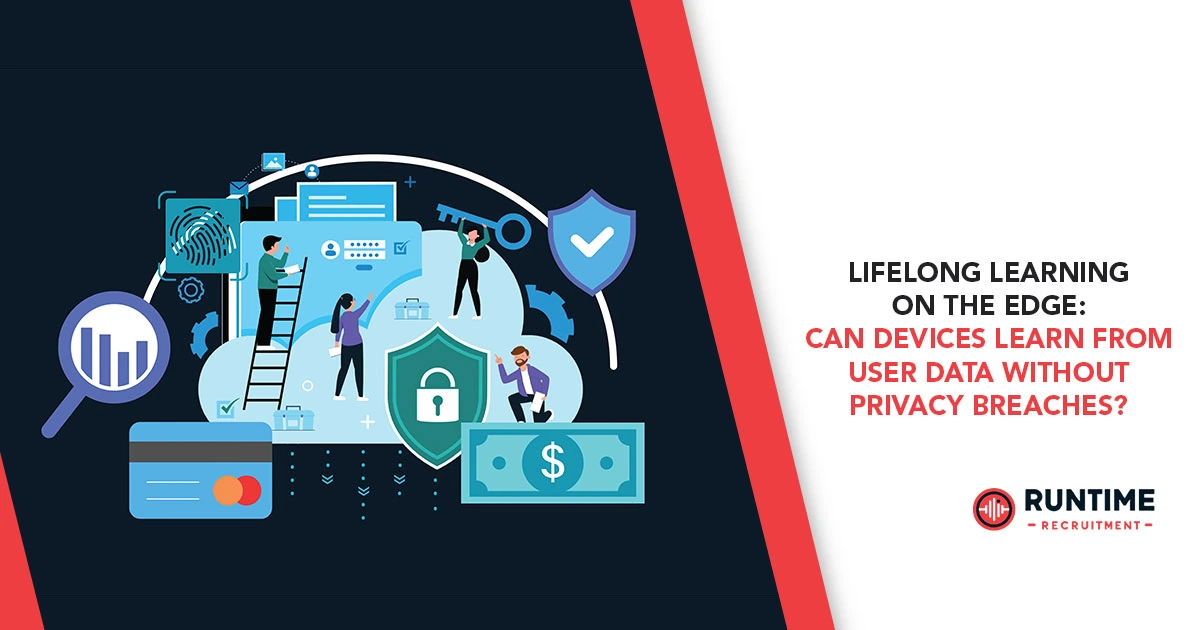The embedded world is undergoing a profound transformation. We’re moving beyond static, pre-programmed devices to a future where intelligence lives not just in the cloud, but right on the edge. This shift brings with it the tantalizing promise of lifelong learning: devices that adapt, optimize, and even anticipate user needs over their operational lifespan. Imagine a smart thermostat that genuinely understands your comfort preferences, an industrial sensor that learns to identify anomalies unique to its specific environment, or a medical implant that fine-tunes its therapy based on your individual physiological responses. The potential is immense.
However, this exciting frontier is fraught with a critical challenge: privacy. For devices to truly learn, they need data – and often, that data is deeply personal. How do we unlock the power of lifelong learning on the edge without inadvertently becoming Big Brother, eroding user trust, and violating fundamental privacy rights? This isn’t just a technical hurdle; it’s an ethical tightrope walk that embedded engineers are uniquely positioned to navigate.
The Allure of Lifelong Learning: Beyond Static Firmware
For decades, embedded systems have been defined by their deterministic nature. Code is written, flashed, and largely remains unchanged until a firmware update. While robust, this model limits adaptability. Lifelong learning, in contrast, envisions devices that continually evolve.
What does lifelong learning look like on the edge?
- Personalization: A smartwatch that learns your sleep patterns, activity levels, and even stress triggers to offer hyper-personalized health insights.
- Adaptation to Environment: A smart building management system that optimizes HVAC and lighting based on real-time occupancy patterns and external weather conditions, learning the nuances of its specific building.
- Predictive Maintenance: Industrial IoT sensors that learn the “normal” operational signature of a machine, predicting failures with increasing accuracy as they accumulate data.
- Resource Optimization: Edge AI accelerators that learn to dynamically adjust their power consumption based on the complexity and frequency of inference tasks.
- Enhanced User Experience: Smart home devices that learn your routines, anticipating your needs – dimming lights as you settle in for the evening, or preheating the oven based on your typical cooking schedule.
The benefits are clear: greater efficiency, enhanced user satisfaction, improved safety, and the ability for devices to remain relevant and valuable for longer periods. This is a paradigm shift, moving from a “set it and forget it” mentality to one of continuous improvement and dynamic interaction.
The Privacy Conundrum: Data is King, but Whose Crown is It?
The engine of lifelong learning is data. Without it, there’s no learning. But user data, especially in the context of embedded devices, is often sensitive. Location data, health metrics, voice commands, behavioral patterns, even the simple act of turning a light on or off – all can paint a detailed picture of an individual’s life.
Why is privacy such a challenge for edge learning?
- Direct Interaction: Embedded devices often interact directly and intimately with users in their homes, bodies, and personal spaces. This proximity means highly granular and personal data.
- Resource Constraints: Edge devices typically have limited computational power, memory, and energy. This makes implementing complex privacy-preserving techniques challenging.
- Connectivity Gaps: While some edge devices are always connected, many operate in intermittently connected or even fully offline environments, complicating centralized data processing or secure cloud-based learning.
- Inherent Trust: Users often implicitly trust their physical devices more than abstract cloud services. A breach on an embedded device can feel like a profound violation.
- Data Persistence: Unlike ephemeral web sessions, data on embedded devices can persist for long periods, raising concerns about its long-term security and potential for misuse.
The legal landscape is also evolving rapidly, with regulations like GDPR, CCPA, and many others worldwide imposing strict requirements on data collection, processing, and storage. Non-compliance can lead to hefty fines and, perhaps more damaging, a catastrophic loss of user trust.
Engineering Solutions: Bridging the Gap Between Learning and Privacy
This is where the ingenuity of embedded engineers truly shines. We need to develop architectures and algorithms that allow devices to learn effectively while safeguarding user privacy. Here are several key strategies:
1. Learning On-Device (Local Learning)
The most direct approach to privacy is to keep data where it belongs: on the device itself. If a device learns from its user’s data without ever transmitting that data off the device, the risk of a breach is significantly reduced.
- Mechanism: Machine learning models are trained directly on the data generated by the device. For example, a smart speaker learns your voice commands and preferences locally, not by sending every utterance to the cloud.
- Advantages: Maximizes privacy, reduces reliance on network connectivity, potentially lower latency.
- Challenges: Limited computational resources on edge devices often restrict the complexity of models that can be trained locally. Model updates and initial training still typically require cloud interaction.
2. Federated Learning (Collaborative Learning Without Centralized Data)
Federated learning offers a powerful middle ground, allowing multiple devices to collaboratively train a shared machine learning model without ever exchanging their raw data.
- Mechanism:
- A central server (often in the cloud) sends an initial model to a group of edge devices.
- Each device trains this model locally using its own data.
- Instead of sending their data back, devices send only the updated model parameters (the “learned changes”) to the central server.
- The server aggregates these updates from many devices to create an improved global model, which is then sent back out for further training rounds.
- Advantages: Significantly enhances privacy by keeping raw data on the device. Allows for more powerful models than purely local learning.
- Challenges: Requires sophisticated aggregation algorithms, can be vulnerable to inference attacks if not properly secured (e.g., inferring user data from model updates), communication overhead, and challenges in dealing with heterogeneous device capabilities and data distributions.
3. Differential Privacy (Adding Noise to Protect Individuals)
Differential privacy is a strong mathematical guarantee of privacy. It involves adding a controlled amount of “noise” to data or model parameters such that the presence or absence of any single individual’s data in a dataset does not significantly alter the outcome of an analysis.
- Mechanism:
- Local Differential Privacy: Noise is added to each individual data point before it’s collected or used for training. This is highly private but can significantly impact model accuracy.
- Central Differential Privacy: Noise is added to the aggregated results or model updates after they are computed. This offers better utility but assumes a trusted aggregator.
- Advantages: Provides a quantifiable and rigorous privacy guarantee. Makes it extremely difficult to infer individual data points.
- Challenges: The “noise” inevitably reduces the accuracy or utility of the learned model. Striking the right balance between privacy and utility is a complex engineering challenge. Resource constraints on edge devices can make implementing cryptographic-level noise addition difficult.
4. Homomorphic Encryption (Computing on Encrypted Data)
Homomorphic encryption is a cryptographic technique that allows computations to be performed directly on encrypted data without decrypting it first. This means a cloud server could process user data and train models without ever seeing the raw, unencrypted information.
- Mechanism: Data is encrypted on the device. The encrypted data is sent to a server. The server performs computations (e.g., model inference, training steps) on the encrypted data. The result is still encrypted and sent back to the device for decryption.
- Advantages: Offers very strong privacy guarantees, as the data remains encrypted throughout its journey and processing.
- Challenges: Extremely computationally intensive. Homomorphic encryption is significantly slower and requires more resources than operations on unencrypted data, making it currently impractical for many real-time or resource-constrained embedded applications. However, ongoing research is rapidly improving its efficiency.
5. Secure Enclaves and Hardware-Based Security
Hardware-level security features, such as secure enclaves (e.g., ARM TrustZone, Intel SGX), provide isolated execution environments on a chip. These enclaves can protect sensitive data and computations from the rest of the system, even if the main operating system is compromised.
- Mechanism: Sensitive data and machine learning model operations are performed within a secure enclave. Data is encrypted when it leaves the enclave.
- Advantages: Provides a robust layer of protection against software attacks.
- Challenges: Adds complexity to software development and deployment. The security relies on the integrity of the hardware implementation.
6. Data Minimization and Anonymization
The simplest, yet often overlooked, privacy strategy is to collect less data in the first place, and to ensure that any collected data is anonymized or pseudonymized as much as possible.
- Mechanism:
- Collect only what’s necessary: Strictly adhere to the principle of data minimization. Do you really need full GPS coordinates, or is a regional location sufficient?
- Aggregating data: Instead of individual data points, transmit only aggregated statistics (e.g., average temperature readings over an hour, not every single reading).
- Pseudonymization: Replace direct identifiers with artificial identifiers. While not fully anonymous, it makes re-identification harder.
- Synthetic Data Generation: Train models on artificial data that mimics the statistical properties of real data but contains no actual personal information.
- Advantages: Reduces the attack surface and the potential impact of a breach. Simpler to implement than complex cryptographic techniques.
- Challenges: Can sometimes limit the richness of data available for learning, potentially impacting model accuracy or the depth of personalization.
The Role of the Embedded Engineer: Beyond Code
As embedded engineers, our responsibility extends far beyond simply making things work. In the era of lifelong learning on the edge, we are the frontline guardians of user privacy. This means:
- Privacy by Design: Integrating privacy considerations from the very initial stages of system design, rather than as an afterthought. This includes architectural choices, data flow diagrams, and threat modeling.
- Security First: Understanding and implementing robust security practices at every layer of the embedded stack – from secure boot and trusted execution environments to secure communication protocols and firmware updates.
- Understanding ML Ethics: Being aware of the ethical implications of the data your devices collect and the models they train. Guarding against bias, ensuring transparency, and giving users control over their data.
- User Consent and Transparency: Designing intuitive user interfaces that clearly communicate what data is being collected, how it’s being used, and offering granular control over privacy settings. It’s not enough to be privacy-preserving; users need to feel it.
- Continuous Learning (for ourselves!): The fields of edge AI, privacy-preserving ML, and embedded security are evolving rapidly. Staying abreast of the latest research, tools, and best practices is crucial.
The Future is Smart, Personal, and Private
The vision of devices that truly learn and adapt over their lifespan is compelling. It promises a world of intelligent, responsive, and deeply personalized technology that seamlessly integrates into our lives. But this future is only sustainable if built on a foundation of trust.
The challenge of lifelong learning on the edge without privacy breaches is one of the most significant and exciting problems facing embedded engineers today. It requires a blend of deep technical expertise, ethical foresight, and a commitment to user empowerment. By embracing strategies like on-device learning, federated learning, differential privacy, hardware security, and meticulous data minimization, we can unlock the immense potential of intelligent edge devices while upholding the fundamental right to privacy.
The journey is complex, but the destination – a world of truly intelligent, trustworthy, and user-centric embedded systems – is well worth the effort. Let’s build that future together.
Ready to Shape the Future of Embedded Systems?
Are you an embedded engineer passionate about building innovative, secure, and privacy-aware edge devices?
RunTime Recruitment connects top talent with leading companies at the forefront of this exciting field. Let’s power the next generation of intelligent systems. Connect with RunTime Recruitment today!









